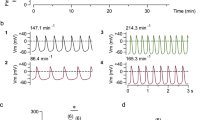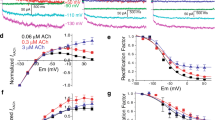Abstract
The effect of the cholinomimetic agent, bethanechol on macroscopic membrane currents was studied in dispersed cat atrial myocytes, using the whole-cell patch-clamp technique. Bethanechol activated an inward rectifying potassium current similar to IK(ACh), and a delayed rectifying-like outward current, similar to IKM3 activated by pilocarpine, choline, and tetramethylammonium, and IKM4 activated by 4-aminopyridine. The relatively specific muscarinic receptors subtype antagonists methoctramine (M2), and tropicamide (M4) inhibited both current components induced by bethanechol, suggesting a lack of specificity of these antagonists on cat atrial myocytes. The specific antagonist of M3 receptors, para-fluoro-hexahydro-siladifenidol did not significantly inhibit the bethanechol-induced currents. In addition, pretreatment with PTX prevented activation of the bethanechol-induced inward and outward currents, suggesting that M3 receptors are probably not involved in the bethanechol action. The IK(ACh) specific blocker tertiapin inhibited both inward rectifying- and delayed rectifying-like currents. These results suggest that both current components result from activation of a single channel type, likely IK(ACh).








Similar content being viewed by others
References
Bonner TI (1989) The molecular basis of muscarinic receptor diversity. Trends Neurosci 12:148–151
Bonner TI, Buckley NJ, Young AC, Brann MR (1987) Identification of a family of muscarinic acetylcholine receptor genes. Science 237:527–532
Breitwieser GE, Szabo G (1985) Uncoupling of cardiac muscarinic and β-adrenergic receptors from ion channels by a guanine nucleotide analogue. Nature 317:538–540
Brown JH, Taylor P (2001) Muscarinic receptor agonists and antagonists. In: Hardman JG, Limbird LE (eds) Goodman and Gilman's the pharmacological basis of therapeutics. McGraw-Hill, New York, pp 155–173
Caulfield MP, Birdsall NJM (1998) International Union of Pharmacology. XVII. Classification of muscarinic acetylcholine receptors. Pharmacol Rev 50:279–290
Dei S, Bellucci C, Ghelardini C, Romanelli NM, Spampinato S (1996) Synthesis, characterization and pharmacological profile of tropicamide enantiomers. Life Sci 58:2147–2153
Dhein S, van Koppen CJ, Brodde OE (2001) Muscarinic receptors in the mammalian heart. Pharmacol Res 44:161–182
Drici MD, Diochot S, Terrenoire C, Romey G, Lazdunski M (2000) The bee venom peptide tertiapin underlines the role of I(KACh) un acetylcholine-induced atrioventricular blocks. Br J Pharmacol 131:569–577
Eglen RM, Whiting RL (1990) Heterogeneity of vascular muscarinic receptors. J Auton Pharmacol 10:233–245
Eglen RM, Hegde S, Watson N (1996) Muscarinic receptor subtypes and smooth muscle function. Pharmacol Rev 48:531–565
Fermini B, Nattel S (1994) Choline chloride activates time-dependent and time-independent K+ currents in dog atrial myocytes. Am J Physiol 266:C42–C51
Hulme EC, Birdsall NJ, Buckley NJ (1990) Muscarinic receptor subtypes. Annu Rev Pharmacol Toxicol 30:633–673
Isenberg G, Klöckner U (1982) Calcium tolerant ventricular myocytes prepared by pre-incubation in a KB-medium. Pflügers Arch 395:6–18
Kitamura H, Yokoyama M, Akita H, Matsushita K, Kurachi Y, Yamada M (2000) Tertiapin potently and selectively blocks muscarinic K+ channels in rabbit cardiac myocytes. J Pharmacol Exp Ther 293:196–205
Krejcic A, Tucek S (2002) Quantitation of mRNAs for M(1) to M(5) subtypes of muscarinic receptors in rat heart and brain cortex. Mol Pharmacol 61:1267–1272
Kurachi Y (1985) Voltage-dependent activation of the inward-rectifier potassium channel in the ventricular cell membrane of guinea-pig heart. J Physiol 366:365–385
Kurachi Y (1995) G protein regulation of cardiac muscarinic potassium channel. Am J Physiol 269:C821–C830
Lazareno S, Birdsall NJ (1993) Pharmacological characterization of acetylcholine-stimulated [35S]-GTPγS binding mediated by human muscarinic m1-m4 receptors: antagonist studies. Br J Pharmacol 109:1120–1127
Lazareno S, Roberts FF (1989) Functional and binding studies with muscarinic M2-subtype selective antagonists. Br J Pharmacol 98:309–317
Lazareno S, Buckley NJ, Roberts FF (1990) Characterization of muscarinic M4 binding sites in rabbit lung, chicken heart, and NG108–15 cells. Mol Pharmacol 38:805–815
Loffelholz K, Pappano AJ (1985) The parasympathetic neuroeffector junction of the heart. Pharmacol Rev 37:1–24
Meyer T, Wellner-Kienitz M-C, Biewald A, Bender K, Eickel A, Pott L (2001) Depletion of phosphatidylinositol 4,5-biphosphate by activation of phospholipase C-coupled receptors causes slow inhibition but not desensitization of G protein-gated inward rectifier K+ current in atrial myocytes. J Biol Chem 276:5650–5658
Mutschler E, Moser U, Wess J, Lambrecht G (1995) Muscarinic receptor subtypes—pharmacological, molecular biological and therapeutical aspects. Pharm Acta Helv 69:243–258
Navarro-Polanco RA, Sánchez-Chapula JA (1997) 4-Aminopyridine activates potassium currents by activation of a muscarinic receptor in feline atrial myocytes. J Physiol 498:663–678
Okamoto H, Prestwich SA, Asai S, Unno T, Bolton TB, Komori S (2002) Muscarinic agonist potencies at three different effector systems linked to the M2 or M3 receptor in longitudinal smooth muscle of guinea-pig small intestine. Br J Pharmacol 135:1765–1775
Sakmann B, Trube G (1984) Voltage-dependent inactivation of inward-rectifying single-channel currents in the guinea-pig heart cell membrane. J Physiol 347:659–683
Sánchez-Chapula JA (1988) Effects of bupivacaine on membrane currents of guinea-pig ventricular myocytes. Eur J Pharmacol 156:303–308
Sanguinetti MC, Jurkiewicz NK (1990) Two components of cardiac delayed rectifier K+ current. Differential sensitivity to block by class III antiarrhythmic agents. J Gen Physiol 96:195–215
Shi H, Wang H, Wang Z (1999a) Identification and characterization of multiple subtypes of muscarinic acetylcholine receptors and their physiological functions in canine hearts. Mol Pharmacol 55:497–507
Shi H, Wang H, Wang Z (1999b) M3 muscarinic receptor activation of a delayed rectifier potassium current in canine atrial myocytes. Life Sci 65:PL143–149
Shi H, Wang H, Lu Y, Yang B, Wang Z (1999c) Choline modulates cardiac membrane repolarization by activating an M3 muscarinic receptor and its coupled K+ channel. J Membr Biol 169:55–64
Soejima M, Noma A (1984) Mode of regulation of the ACh-sensitive K-channel by the muscarinic receptor in rabbit atrial cells. Pflügers Arch 400:424–431
Van Zwiten PA, Doods HN (1995) Muscarinic receptors and drugs in cardiovascular medicine. Cardiovasc Drugs Ther 9:159–167
Wang H, Shi H, Lu Y, Yang B, Wang Z (1999) Pilocarpine modulates the cellular electrical properties of mammalian hearts by activating a cardiac M3 receptor and a K+ current. Br J Pharmacol 126:1725–1734
Yamada M, Inanobe A, Kurachi Y (1998) G protein regulation of potassium ion channels. Pharmacol Rev 50:723–757
Zang WJ, Yu XJ, Boyett MR (1995) Barium block of the muscarinic potassium current in guinea-pig atrial cells. Pflügers Arch 430:348–357
Acknowledgements
We thank Dr. Michael Sanguinetti for critical reading of the manuscript. This work was supported by Consejo Nacionl de Ciencia y Tecnologia (CONACyT, México) grant 35136-N (to RANP) and grant 41536-M (to JASCh). These experiments were approved by the Ethics Committee of the University of Colima, Colima, Col., México.
Author information
Authors and Affiliations
Corresponding author
Rights and permissions
About this article
Cite this article
Benavides-Haro, D.E., Navarro-Polanco, R.A. & Sánchez-Chapula, J.A. The cholinomimetic agent bethanechol activates IK(ACh) in feline atrial myocytes. Naunyn-Schmiedeberg's Arch Pharmacol 368, 309–315 (2003). https://doi.org/10.1007/s00210-003-0789-1
Received:
Accepted:
Published:
Issue Date:
DOI: https://doi.org/10.1007/s00210-003-0789-1




